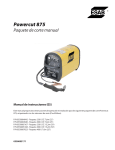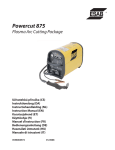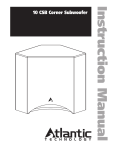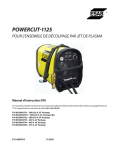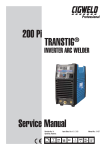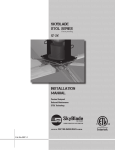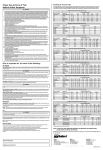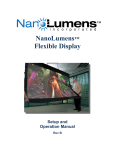Download ESAB Powercut 875 Instruction manual
Transcript
Powercut 875 Plasma Arc Cutting Package Instruction Manual This manual provides installation and operation instructions for the following Powercut 875 cutting packages starting with Serial No. (PxxJ434xxx). P/N 0558004942 - 230 V, CE 7.6m (25') Package P/N 0558004940 - 400 V, CE 7.6m (25') Package P/N 0558005167 - 230 V, CE 15.2m (50') Package P/N 0558005168 - 400 V, CE 15.2m (50') Package 0558004972 09 / 2004 Be sure this information reaches the operator. You can get extra copies through your supplier. USER RESPONSIBILITY This equipment will perform in conformity with the description thereof contained in this manual and accompanying labels and/or inserts when installed, operated, maintained and repaired in accordance with the instructions provided. This equipment must be checked periodically. Malfunctioning or poorly maintained equipment should not be used. Parts that are broken, missing, worn, distorted or contaminated should be replaced immediately. Should such repair or replacement become necessary, the manufacturer recommends that a telephone or written request for service advice be made to the Authorized Distributor from whom it was purchased. This equipment or any of its parts should not be altered without the prior written approval of the manufacturer. The user of this equipment shall have the sole responsibility for any malfunction which results from improper use, faulty maintenance, damage, improper repair or alteration by anyone other than the manufacturer or a service facility designated by the manufacturer. CAUTION These INSTRUCTIONS are for experienced operators. If you are not fully familiar with the principles of operation and safe practices for arc welding and cutting equipment, we urge you to read our booklet, "Precautions and Safe Practices for Arc Welding, Cutting, and Gouging," Form 52-529. Do NOT permit untrained persons to install, operate, or maintain this equipment. Do NOT attempt to install or operate this equipment until you have read and fully understand these instructions. If you do not fully understand these instructions, contact your supplier for further information. Be sure to read the Safety Precautions before installing or operating this equipment. 66 TABLE OF CONTENTS SECTION PARAGRAPH TITLE PAGE SECTION 1 SAFETY ...................................................................................................................................................... 69 SECTION 2 2.1 2.2 2.3 2.4 2.5 DESCRIPTION.......................................................................................................................................... General ....................................................................................................................................................... Scope .......................................................................................................................................................... Packages Available ................................................................................................................................. Specifications ........................................................................................................................................... Optional Accessories ............................................................................................................................. 71 71 71 71 72 74 SECTION 3 3.1 3.2 3.3 3.4 3.5 3.6 INSTALLATION ....................................................................................................................................... General ....................................................................................................................................................... Equipment Required ............................................................................................................................. Location ..................................................................................................................................................... Inspection.................................................................................................................................................. Primary Electrical Input Connections .............................................................................................. Secondary Output Connections ....................................................................................................... 75 75 75 75 75 75 76 SECTION 4 4.1 4.2 4.3 4.4 OPERATION ............................................................................................................................................. Operation .................................................................................................................................................. Powercut 875 Controls ......................................................................................................................... Cutting with the PT-32EH .................................................................................................................... Common Cutting Problems ................................................................................................................ 79 79 79 80 83 SECTION 5 5.1 5.2 5.3 5.4 MAINTENANCE ...................................................................................................................................... 205 General ....................................................................................................................................................... 205 Inspection and Cleaning ...................................................................................................................... 205 PT-32EH Torch Consumable Parts ..................................................................................................... 205 IGBT Handling and Replacement ...................................................................................................... 207 SECTION 6 6.1 6.2 6.3 6.4 TROUBLESHOOTING ........................................................................................................................... 209 Troubleshooting ..................................................................................................................................... 209 Troubleshooting Guide ........................................................................................................................ 209 Reference Voltage Checks ................................................................................................................... 214 Sequence of Operation ........................................................................................................................ 215 SECTION 7 7.1 7.2 REPLACEMENT PARTS ........................................................................................................................ 217 General ....................................................................................................................................................... 217 Ordering ..................................................................................................................................................... 217 67 TABLE OF CONTENTS 68 SECTION 1 SAFETY Full responsibility for safety of personnel working on or near system rests on user of ESAB Welding Equipment. Wrong operation can lead to abnormal situation, injure operator and damage equipment. All personnel working with welding equipment must be fully familiar with - handling of equipment - location of emergency stops - functions of equipment - applicable safety regulations - cutting Operator must make sure - no one stays inside work area while machine starts - no one is unprotected while arc is being struck Work area must be - free of machine parts, tools and other objects that can obstruct operator moving within area - so arranged, that emergency stop buttons are easily accessible - free from draughts Personal safety equipment - always use proper safety equipment such as goggles, non flammable clothing, protective gloves - never wear loose clothing, belts, bracelets, rings etc., which may catch on equipment or cause burns Miscellaneous - only authorised personnel may operate electrical equipment - check whether return cables are properly fitted and earthen - requisite fire fighting equipment should be easily available in specially and clearly marked areas - lubrication and maintenance of welding equipment must not be proceeded during operation. 69 SECTION 1 SAFETY ! WARNING ! ARC WELDING AND CUTTING CAN BE INJURIOUS TO YOURSELF AND OTHERS. TAKE PRECAUTIONS WHEN WELDING OR CUTTING. ASK YOUR EMPLOYER FOR SAFETY PRACTICES THAT SHOULD BE BASED ON MANUFACTURER’S HAZARD DATA. ELECTRIC SHOCK - Can kill - Install and earth welding equipment in accordance with obligatory standards. - Do not touch live electrical parts or electrodes with bare skin, wet gloves or wet clothes. - Insulate yourself from earth and workpiece. - Ensure your work position is safe. FUMES AND GASES - Can be dangerous to your health - Keep your head away from fumes. - Use ventilation and/or extraction to keep fumes and gases away from your breathing zone and surroundings. ARC RAYS - Can injure eyes and burn skin - Protect your eyes and skin. Use correct welding screens, filter lens and wear protective clothes. - Protect bystanders with suitable screens or curtains. FIRE HAZARD - Sparks (spatter) can cause fire. Make therefore sure there are no inflammable materials nearby. NOISE - Excessive noise can damage your hearing. - Protect your ears. Use ear defenders or other hearing protection. - Warn bystanders of the risk. MALFUNCTION - Call expert assistance in event of malfunction. READ AND UNDERSTAND THE INSTRUCTION MANUAL BEFORE INSTALLING OR OPERATING UNIT PROTECT YOURSELF AND OTHERS ! 70 SECTION 2 DESCRIPTION 2.1 WARNING Use only The ESAB PT-32EH Plasmarc torch with this console. Use of torches not designed for use with this console could create an ELECTRIC SHOCK HAZARD. GENERAL The Powercut is a compact, completely self-contained plasma cutting system. As shipped, the system is fully assembled and ready to cut after being connected to input power and a source of compressed air; 6.210.3bar (90-150 psi). The Powercut 875 package uses the heavy-duty PT-32EH torch to deliver cutting power for severing materials up to 31.8mm (1-1/4") thick. Refer to the following paragraphs for descriptions of the Powercut 875 packages available as well as performance specifications. 2.2 SCOPE The purpose of this manual is to provide the operator with all the information required to install and operate the Powercut 875 plasma arc cutting package. Technical reference material is also provided to assist in troubleshooting the cutting package. 2.3 PACKAGES AVAILABLE 2.3.1 Manual Cutting Packages Powercut 875 packages listed on the front cover and below, includes the following components: PT-32EH Torch, 75o head, 7.6m (25') ....................................0558003548 PT-32EH Torch, 75o head, 15.2m (50') .................................0558003549 PT-32EH 230V/400V Long Heat Shield (LHS) Spare Parts Kit - CE Units Only .............................0558004949 Note: Torches and torch body assemblies are supplied without electrodes, nozzles, heat shields or valve pins. Order individual consumables shown in spare parts kit on Page 10. Depending on the choice of input power, each package includes the following appropriate Powercut 875 Console/Power Source: 230V, 50Hz, 3-phase CE ................................................... P/N 0558004941 400V, 50Hz, 3-phase CE ................................................... P/N 0558004939 Powercut 875 Manual Cutting Packages: 230V, 50Hz, 3-phase CE, 7.6m (25') Package ........... P/N 0558004942 400V, 50Hz, 3-phase CE, 7.6m (25') Package ........... P/N 0558004940 230V, 50Hz, 3-phase CE, 15.2m (50') Package ......... P/N 0558005167 400V, 50Hz, 3-phase CE, 15.2m (50') Package ......... P/N 0558005168 71 SECTION 2 DESCRIPTION 2.4 SPECIFICATIONS Table 2-1. Powercut 875 Specifications Rated Output 60% Duty Cycle* 60 A @ 120 V dc 100% Duty Cycle* 50 A @ 120 V dc Output Current Range 20 to 60 Amperes Open Circuit Voltage Rated Primary Input @ 7.2 kW Max. Output Power 60 A @ 120 Vdc 275 V dc 230 Vac, 50/60 Hz, 3-ph 24 A/phase 400 Vac, 50/60 Hz, 3-phase 13 A/phase Power Factor @ 60 Amperes Output Efficiency @ 60 Amperes Output Current Capacity Air Requirements Dimensions 74% (208/230 V, 1-phase) 90% (208/230 V, 3-phase) 92% (400 V & 460 V, 3-phase) PT-32EH PT-32EH Length Height w/handles Width w/o opt. storage w/ opt. torch storage Weight of Powercut 875 System Shipping Weight 90% Typical 90 A DCSP 360 cfh @ 75 psig (150 l/min @ 5.2 bars) “20.3”” (516 mm) 16.1"” (409 mm) 18.3"” (465 mm) 10.1"” (275 mm) 13.1"” (333 mm)” 87 lbs (39.5 kg) 102 lbs (46.4 kg) *Duty cycle is based on a 10-minute period; therefore, a 60-percent duty cycle means the power source may operate for 6 minutes with a cool down period of 4 minutes and a 100-percent duty cycle means the power source may operate continuously. 72 SECTION 2 DESCRIPTION Table 2-2. PT-32EH Torch Specifications Current Capacity (100% Duty) Length of Service Lines Weight 7.6m (25') 15.2m (50') 90 A DCSP 7.6m (25') or 15.2m (50') 3.031" (77mm) 75° 5.2 lbs (2.4kg) 9.6 lbs (4.4kg) Figure 2-1. PT-32EH Dimensions 1.16" (27mm) PT-32EH CUT SPEEDS -- Carbon Steel 3048mm (120") Cut Speed 2540mm (100") 2032mm (80") Speeds shown produce excellent quality drop cuts 1524mm (60") Maximum speeds are approximately 20% higher. 1016mm (40") 508mm (20") 0 6.4mm (0.25") 12.7mm (0.50") 19.1mm (0.75") 25.4mm (1.00") Material Thickness PT-32EH CUTTING SPEEDS AIR @ 5.2 bar (75PSI) and OUTPUT CURRENT 40AMPS Thickness mm (in.) Cutting Speed mm/min. (in./min.) Carbon Steel 1.6mm (1/16") 3.2mm (1/8") 6.4mm (1/4") 9.5mm (3/8") 12.7mm (1/2") 5080mm (200") 2489mm (98") 914mm (36") 457mm (18") 279mm (11") Stainless Steel 1.6mm (1/16") 3.2mm (1/8") 6.4mm (1/4") 9.5mm (3/8") 12.7mm (1/2") 3505mm (138") 1473mm (58") 457mm (18") 254mm (10") 152mm (6") Aluminum 1.6mm (1/16") 3.2mm (1/8") 6.4mm (1/4") 9.5mm (3/8") 12.7mm (1/2") 5080mm (200") 2794mm (110") 1219mm (48") 432mm (17") 356mm (14") Material Figure 2-2. PT-32EH / Powercut 875 Cutting Performance 73 31.8mm (1.25") SECTION 2 DESCRIPTION IMPORTANT!!! Maintain Proper Stand-Off Distance 4.8mm to 6.4mm (3/16" to 1/4") Power Output increases with Stand Off Distance! Figure 2-3. Standoff vs. Power Output 2.5 OPTIONAL ACCESSORIES 1. Torch Wrap / Spare Parts Kit Holder, P/N 0558003013 Units can be mounted to either side of machine using the two upper mounting positions of the end cap handles. 2. Wheel Cart, P/N 0558003014 This 98.4mm (3-7/8") high cart has front and rear heavy duty swivel caster to make it easier to roll the Powercut 875 around the job site. Table 2-3. PT-32EH CE Spare Parts Kit, P/N 0558004949, Contents Description 50-70 Amp Nozzle 40A Drag Nozzle Electrode Long Heat Shield Valve Pin Stand Off Guide Wrench 74 Part Number Quantity 0558002618 0558002908 0558001969 0558003110 0558001959 0558002393 0558000808 (19129) 4 1 3 2 1 1 1 SECTION 3 INSTALLATION 3.1 GENERAL Proper installation is important for satisfactory and trouble-free operation of the Powercut 875 cutting package. It is suggested that each step in this section be studied carefully and followed closely. 3.2 EQUIPMENT REQUIRED A source of clean, dry air that supplies 170l/m at 5.2 bar (360 cfh at 75 psig) is required for the cutting operation. The air supply should not exceed 10.3 bar (150 psig) - the maximum inlet pressure rating of the air filter-regulator supplied with the package. A brass 45° 6.4mm (1/4") NPT Female x 6.4mm (1/4") NPT male street elbow is recommended for attaching the air hose to the regulator. This elbow will provide greater clearance around the handle. 3.3 CAUTION Installing or placing any type of filtering device will restrict the volume of intake air, thereby subjecting the power source internal components to overheating. The warranty is void if any type of filter device is used. Adequate ventilation is necessary to provide proper cooling of the Powercut 875. The amount of dirt, dust, and excessive heat to which the equipment is exposed, should be minimized. There should be at least one foot of clearance between the Powercut 875 power source and wall or any other obstruction to allow freedom of air movement through the power source. 3.4 WARNING ELECTRIC SHOCK CAN KILL! Precautionary measures should be taken to provide maximum protection against electrical shock. Be sure that all power is off by opening the line (wall) disconnect switch and by unplugging the power cord to the unit when connections are made inside of the power source. CAUTION Be sure that the power source is properly configured for your input power supply. DO NOT connect a power source configured for 230 V to a 400 V input power supply. Damage to the machine may occur. LOCATION INSPECTION A. Remove the shipping container and all packing material and inspect for evidence of concealed damage which may not have been apparent upon receipt of the Powercut 875. Notify the carrier of any defects or damage at once. B. Check container for any loose parts prior to disposing of shipping materials. C. Check air louvers and any other openings to ensure that any obstruction is removed. 3.5 PRIMARY ELECTRICAL INPUT CONNECTIONS (FIGURE3-1) The Powercut 875 consoles are equipped with a 3.0m (10'), 4-conductor input power cable for 3-phase connection. If single-phase connection is desired, tape back the red wire on the input power cable. 75 SECTION 3 WARNING The chassis must be connected to an approved electrical ground. Failure to do so may result in electrical shock, severe burns or death. INSTALLATION A line (wall) disconnect switch with fuses or circuit breakers should be provided at the main power panel (see Fig. 3-1 and Table 3-1 for fuse sizes). The input power cable of the console may be connected directly to the disconnect switch or you may purchase a proper plug and receptacle from a local electrical supplier. If using plug/receptacle combination, see Table 3-1 for recommended input conductors for connecting receptacle to line disconnect switch. Table 3-1. Recommended Sizes For Input Conductors and Line Fuses Input Requirements Volts 230 400 WARNING Before making any connections to the power source output terminals, make sure that all primary input power to the power source is deenergized (off) at the main disconnect switch and that the input power cable is unplugged. 3.6 1. 2. 3. 4. 5. Phase Amps 3 3 24A/Ph. 13A/Ph. Input & Gnd Fuse Conductor Size CU/AWG Amps 6 10 50 25 SECONDARY (OUTPUT) CONNECTIONS (REFER TO FIG. 3-1) For operator safety, the torch connections are located on the output terminal board behind the lower portion of the front panel. Remove access cover to output terminal compartment from lower front panel of power source. Thread the power cable, pilot arc cable and switch lead of the PT-32EH through the open bushing of the cover. Connect power cable to the torch fitting (left-hand threads); attach the pilot arc cable connection to the Pilot Arc bulkhead adaptor; and plug in the switch lead to the torch switch receptacle on the output terminal. Make sure the power and pilot arc cable connections are wrenchtight. Make sure plug of switch lead is firmly inserted in place. Reassemble the access cover to the power source. Connect your air supply to the inlet connection of the filter-regulator. Clamp the work cable to the workpiece. Be sure the workpiece is connected to an approved earth ground with a properly sized ground cable. 76 SECTION 3 INSTALLATION Allow at least 10 ft. (3m) between work and power source WORK SAFETY GROUND ACCESS COVER FOR TORCH CONNECTION ACCESS FOR CNC INTERFACE CONNECTIONS. (See Detail “A”) PT-32EH Use a Brass 45° 6.4mm (1/4") NPT Female x 6.4mm (1/4") NPT male street elbow for better clearance around the handle. Prefiltered AIR SUPPLY (Customer Supplied) 6.2 to 10.3 bar (90 to 150 psig max) CUSTOMER FUSED LINE DISCONNECT SWITCH (See Table 2.1 and WARNING in regards to chassis ground in Section 3.5.) INPUT POWER CABLE (See Table 3.1) Figure 3-1. Powercut 875 Interconnection Diagram 77 SECTION 3 INSTALLATION 78 SECTION 4 OPERATION WARNING ELECTRIC SHOCK can kill. • Do NOT operate the unit with the cover removed. • Do NOT apply power to the unit while holding or carrying the unit. • Do NOT touch any torch parts forward of the torch handle (nozzle, heat shield, electrode, etc.) with power switch on. WARNING 4.1 OPERATION 4.2 Powercut 875 CONTROLS (FIGURE 4-1) A. Power Switch (located on rear panel). When placed in ON position, the white pilot light will glow indicating control circuit is energized and the cooling fan will run. B. Output Current Control. Adjustable from 20 to 60 amperes. C. Air Test Switch / Air Regulator. When placed in Test position, air filter-regulator can be adjusted to desired pressure 4.5 - 5.2 bar (65-75 psig) before cutting operations. Allow air to flow for a few minutes. This should remove any condensation that may have accumulated during shutdown period. Be sure to place switch in OPERATE position before starting cutting operations. D. Trigger Lock Switch. When placed in LOCK position, this permits releasing torch switch button after cutting arc has been initiated. To extinguish arc at end of cut, press and release torch switch button again or pull torch away from work. When placed in UNLOCK position, torch switch must be held closed by the operator during the entire cutting operation and then released at the end of cut. E. Fault Light. Will glow amber under the following conditions and operations will come to a complete stop. ARC RAYS can burn eyes and skin; NOISE can damage hearing. • Wear welding helmet with No. 6 or 7 lens shade. • Wear eye, ear, and body protection. CAUTION Position the Powercut 875 at least 10 feet (3 meters) from the cutting area. Sparks and hot slag from the cutting operation can damage the unit. Flow Fault: The fault light will be on but will blink off for about 1/10th of a second every second. This indicates that the air flow supply is low or has no back pressure. Over Temperature: The fault light will be off but will blink on for about 1/10th of a second every second. This indicates that the duty cycle has been exceeded. Allow the power source to cool down before returning to operate. High/Low Line Voltage: The fault light will rapidly blink on and off (five times per second). This indicates that the input voltage is outside the “+ or -” 15% range of the input rating. Over-Current: The fault light will be on continuously. This indicates that input current has been exceeded. All fault signals will remain on for a minimum of 10 seconds. If fault clears, all will reset automatically except for over-current. To clear over-current, the power must be shut off for 5 seconds and then turned back on. F. Air Pressure Gauge: Recommended air pressure should be set to 4.8 bar (70 psi). 79 SECTION 4 OPERATION POWER LIGHT (WHITE) REAR VIEW FAULT LIGHT (AMBER) AIR PRESSURE GAUGE AIR REGULATOR CONTROL KNOB FUSE (3A) CURRENT CONTROL KNOB TRIGGER LOCK SWITCH AIR TEST SWITCH POWER ON-OFF (I-O) SWITCH Figure 4-1. Powercut 875 Controls 4.3 CUTTING WITH THE PT-32EH Use the following procedures to cut with the PT-32EH torch (Figure 4-4). A. Hold the torch nozzle approximately 3.2mm to 4.8mm (1/8" to 3/16") above the work and tilted at about 15 - 30°. This reduces the chance of spatter entering the nozzle. If the PT-32EH's standoff tool (P/N 0558002393) is being used, the difference between the electrode and workpiece is approximately 4.8mm (3/16"). B. Depress the torch switch. Air should flow from the torch nozzle. C. Two seconds after depressing the torch switch, the pilot arc should start. The main arc should immediately follow, allowing the cut to begin. (If using the trigger LOCK mode, torch switch may be released after establishing the cutting arc.) D. After starting the cut, the torch should be maintained at a 5-15° forward angle (Figure 4-2). This angle is especially useful in helping to create a "drop" cut. When not using the standoff guide, the nozzle should be held approximately 6.4mm (1/4 ") from the work. E. When ending a cut, the torch switch should be released (press and release if using trigger LOCK mode) and lifted off the workpiece just before the end of the cut. This is to prevent the high frequency from reigniting after cutting arc extinguishes and causing damage to the nozzle (double arcing). 80 SECTION 4 OPERATION CUT DIRECTION Figure 4-2. Recommended Torch Angle of 5° to 15° F. NOTE: For rapid re-starts, such as grate or heavy mesh cutting, do not release the torch switch. In the postflow mode, the arc can be restarted immediately by depressing the torch switch. This avoids the 2-second preflow portion of the cutting cycle. When replacing the nozzle, always inspect the electrode for wear. If more than 1.6mm (.06") of electrode Hafnium has eroded, replace the electrode. If the electrode is used beyond this recommended wear limit, damage to the torch and power source may occur. Nozzle life is also greatly reduced when using the electrode below the recommended limit. Refer to Figure 4-3. Replace when eroded beyond 1.6mm (0.06") depth. NEW CAUTION WORN REPLACE ELECTRODE BEFORE PITTING BECOMES DEEPER THAN 1.6 MM (0.06") Figure 4-3. Electrode Wear Limit 4.3.1. Drag Cutting with the PT-32EH / Powercut 875 System If dragging cutting is desired, attach ESAB's standoff guide (P/N 0558002393). Then follow steps in Section 4.3. If drag cutting is desired for thin material, under 9.5mm (3/8"), remove 70 amp nozzle from torch head, insert ESAB's 40 amp nozzle (P/N 0558002908). Lower current level to 40 amps or lower, (see Auto Drag Scale on front panel). Then follow steps in Section 4.3. Also refer to PT-32EH Instruction Manual 0558003746. 81 SECTION 4 OPERATION NOTICE Drag cutting, even with lower current levels may significantly reduce the life of torch consumables. Attempting to Drag Cut with higher currents (70 amps) may cause immediate catastrophic consumable damage. ADJUST GUIDE BY TURNING IN A CLOCKWISE DIRECTION ONLY. THIS WILL PREVENT ACCIDENTAL LOOSENING OF SHIELD. STEEL GUARD STAND OFF GUIDE P/N 0558002393 IF GUIDE IS TOO TIGHT ON SHIELD, OPEN SLOT WITH SCREWDRIVER. GUIDE AGAINST STRAIGHT EDGE OR FREE-HAND CUT THIN GAUGE MATERIALS CAN BE CUT WITH 1.6 mm (1/16") TORCH-TO-WORK DISTANCE ADJUST TO 4.8 mm (3/16") FOR MATERIALS OVER 6.4mm (1/4") THICK 1.6mm (1/16") TO 6.4mm (1/4") TORCH-TO-WORK Figure 4-4. Installation and Operation of Steel Heat Shield Guards 82 IF TOO LOOSE, CLOSE SLOT WITH VISE OR LARGE PLIERS. SECTION 4 OPERATION 2 1 WHEN THE ARC BREAKS THROUGH THE WORK, BRING THE TORCH TO AN UPRIGHT POSITION AND PROCEED TO CUT. TO START A PIERCE, TILT THE TORCH TO PREVENT MOLTEN MATERIAL FROM COMING BACK AGAINST AND DAMAGING THE TORCH. Figure 4-4. Piercing Technique using the PT-32EH 4.4 COMMON CUTTING PROBLEMS Listed below are common cutting problems followed by the probable cause of each. If problems are determined to be caused by the Powercut 875, refer to the maintenance section of this manual. If the problem is not corrected after referring to the maintenance section, contact your ESAB distributor. A. Insufficient Penetration. 1. 2. 3. 4. 5. Current too low. Cutting speed too fast. Damaged cutting nozzle. Improper air pressure. Low air flow rate. B. Main Arc Extinguishes. 1. 2. Cutting speed too slow. Worn electrode. C. Dross Formation. (In some materials and thicknesses, it may be impossible to get dross-free cuts.) 1. 2. 3. 4. 5. Current too low. Cutting speed too fast or too slow. Improper air pressure. Faulty nozzle or electrode. Low air flow rate. 83 SECTION 4 OPERATION D. Double Arcing. (Damaged Nozzle Orifice.) 1. 2. 3. 4. E. Uneven Arc. 1. F. Low air pressure. Damaged cutting nozzle. Loose cutting nozzle. Heavy spatter accumulation on nozzle. Damaged cutting nozzle or worn electrode. Unstable Cutting Conditions. 1. 2. 3. Incorrect cutting speed. Loose cable or hose connections. Electrode and/or cutting nozzle in poor condition. G. Main Arc Does Not Strike. 1. 2. 3. Worn electrode. Loose connections. Worn cable not attached. H. Poor Consumable Life. 1. 2. 3. Improper gas pressure. Contaminated air supply. Low air flow rate. 84





















